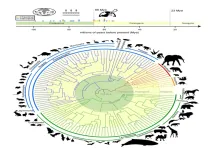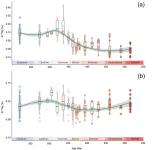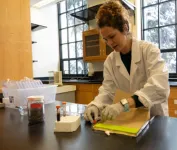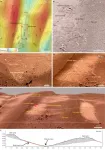(Press-News.org) Astronomers from McGill University are part of an international team that has discovered 25 new sources of repeating fast radio bursts (FRBs), these explosions in the sky that come from far beyond the Milky Way. This discovery brings the total number of confirmed FRB sources to 50. Based on data gathered by the CHIME/FRB collaboration, the new study, published this week in The Astrophysical Journal, may also bring scientists closer to understanding the origins of these mysterious phenomena.
A new way of identifying FRBs
Thanks to the radio telescopes such as those at CHIME, which scan the entire northern sky every day, the number of detected FRBs has grown exponentially in recent years. The research team used a new set of statistical tools they developed to go over the data gathered by CHIME between September 30, 2019, and May 1, 2021, to confirm whether what they were saying were indeed FRBs.
“We combed through the data to find every repeating source detected so far, including the less obvious ones,” says Ziggy Pleunis, the first author of the paper who started working on the research as a PhD student at McGill University. He is now a Dunlap Postdoctoral Fellow at the Dunlap Institute for Astronomy and Astrophysics. “These new tools were essential for this study because we can now accurately calculate the probability that two or more bursts coming from similar locations are not just a coincidence. It should be very useful for similar research going forward.”
"These new discoveries will allow the scientific community to study more repeating FRBs in fantastic detail across the full electromagnetic spectrum and help answer a major open-question in the field: Do repeating and non-repeating FRBs originate from distinct populations?” Adds Aaron Pearlman, an FRQNT postdoctoral fellow at McGill University’s Trottier Space Institute who also collaborated on the paper. “I'm excited for the new insights that will be unlocked as a result of our study."
"It is exciting that CHIME/FRB saw multiple flashes from the same locations, as this allows for the detailed investigation of their nature,” says Adaeze Ibik, a PhD student in the David A. Dunlap Department for Astronomy and Astrophysics at the University of Toronto, who has led the search for the galaxies in which some of the newly identified repeating FRBs are embedded.
“We were able to hone in on some of these repeating sources and have already identified likely associated galaxies for two of them.”
Shedding light on the mysterious origins of FRBs
FRBs are considered one of the biggest mysteries in astronomy, but their exact origins are unknown. Astronomers do know that they come from far outside our Milky Way and are most likely produced by the cinders left behind after stars die.
One unexpected finding described in the paper is that contrary to what has previously been thought, all FRBs may be repeaters rather than one-offs. It is simply that many repeating FRBs are surprisingly inactive, producing fewer than one burst per week, and that the apparently one-off FRBs have simply not been observed for long enough until now for a second burst to be detected.
Pleunis notes that this new research brings us closer to understanding what FRBs are.
“FRBs are likely produced by the leftovers from explosive stellar deaths. By studying repeating FRB sources in detail, we can study the environments that these explosions occur in and understand better the end stages of a star's life. We can also learn more about the material that's being expelled before and during the star’s demise, which is then returned to the galaxies that the FRBs live in.”
The study:
“CHIME/FRB Discovery of 25 Repeating Fast Radio Burst Sources” by Bridget Andersen et al published in The Astrophysical Journal
DOI: 10.3847/1538-4357/acc6c1
The Trottier Institute:
The Trottier Space Institute at McGill is an interdisciplinary center that brings together researchers engaged in astrophysics, planetary science, atmospheric science, astrobiology and other space-related research at McGill University. The main goals of the Institute are to:
Provide an intellectual home for faculty, research staff, and students engaged in astrophysics, planetary science, and other space-related research at McGill University.
Support the development of technology and instrumentation for space-related research.
Foster cross-fertilization and interdisciplinary interactions and collaborations among Institute members in Institute-relevant research areas.
Share with students, educators, and the public an understanding of and an appreciation for the goals, techniques and results of the Institute's research.
END
Doubling the number of sources of repeating fast radio bursts
New technique for identifying FRBs offers promise of further discoveries
2023-04-28
ELSE PRESS RELEASES FROM THIS DATE:
Previously unknown intercellular electricity may power biology
2023-04-28
The human body relies heavily on electrical charges. Lightning-like pulses of energy fly through the brain and nerves and most biological processes depend on electrical ions traveling across the membranes of each cell in our body.
These electrical signals are possible, in part, because of an imbalance in electrical charges that exists on either side of a cellular membrane. Until recently, researchers believed the membrane was an essential component to creating this imbalance. But that thought was turned on its head when researchers at Stanford University discovered that similar imbalanced electrical charges can exist between microdroplets of water ...
Texas A&M research redefines mammalian tree of life
2023-04-28
Research led by a team of scientists from the Texas A&M School of Veterinary Medicine and Biomedical Sciences puts to bed the heated scientific debate regarding the history of mammal diversification as it relates to the extinction of the non-avian dinosaurs. Their work provides a definitive answer to the evolutionary timeline of mammals throughout the last 100 million years.
The study, published in Science, is part of a series of articles released by the Zoonomia Project, a consortium of scientists from around the globe that is using the largest mammalian genomic dataset in history to determine the evolutionary history of the human genome in the context of mammalian evolutionary history. ...
Twelve outstanding journalists named 2023 MBL Logan Science Journalism Fellows
2023-04-28
WOODS HOLE, Mass. –Twelve accomplished science and health journalists have been awarded a highly competitive fellowship in the Logan Science Journalism Program at the Marine Biological Laboratory (MBL).
Now in its 36th year, the Logan Science Journalism Program provides journalists with immersive, hands-on research training, giving them invaluable insight into the practice of science as well as some of the major news stories of today. The program, which offers a Biomedical course and an Environmental course, will run May 30-June 9 in Woods Hole.
Biographies ...
Improved gene editing method could power the next generation of cell and gene therapies
2023-04-28
PHILADELPHIA— A new approach to the genetic engineering of cells promises significant improvements in speed, efficiency, and reduction in cellular toxicity compared to current methods. The approach could also power the development of advanced cell therapies for cancers and other diseases, according to a study from researchers in the Perelman School of Medicine at the University of Pennsylvania.
In the study, which appeared this week in Nature Biotechnology, researchers found that protein fragments used by some viruses to help them get into cells could ...
ATAD3A: A molecular determinant favoring head and neck cancer development
2023-04-28
“[...] developing targeted therapies that specifically inhibit ATAD3A in cancer cells while sparing normal cells will be a challenging but critical task.”
BUFFALO, NY- April 28, 2023 – A new research perspective was published in Oncoscience (Volume 10) on April 4, 2023, entitled, “Mitochondrial regulator ATAD3A: a molecular determinant favoring head and neck cancer development.”
In addition to their role in energy metabolism, mitochondria play important roles in other cellular processes, such as apoptosis, calcium signaling and the synthesis of certain biomolecules. Mitochondria have also been ...
Vascular plants colonized land extensively by the early Silurian: Study
2023-04-28
The colonization and expansion of plants on land represent a defining landmark for the path of life on Earth. Terrestrial colonization has been attributed to a series of major innovations in plant body plans, anatomy, and biochemistry that transformed global biogeochemical cycles and climates.
It is crucial to identify the onset and track the expansion of those earliest land plants. However, the precise timing of land colonization by vascular plants remains controversial due to the sparseness of early land plant megafossils, poor stratigraphic controls ...
Machine learning helps scientists identify the environmental preferences of microbes
2023-04-28
Researchers have figured out a way to predict bacteria’s environmental pH preferences from a quick look at their genomes, using machine learning. Led by experts at the University of Colorado Boulder, the new approach promises to help guide ecological restoration efforts, agriculture, and even the development of health-related probiotics.
“We know that in any environment, there’s a ton of bacteria with important ecological functions, but their environmental preferences often remain unknown,” said Noah Fierer, a fellow of the Cooperative Institute for Research in Environmental ...
Tianwen-1: Zhurong Rover finds evidence of water at low latitudes on modern Mars
2023-04-28
The Zhurong rover has found evidence of water on dune surfaces on modern Mars by providing key observational proof of liquid water at low Martian latitudes, according to a study led by Prof. QIN Xiaoguang from the Institute of Geology and Geophysics (IGG) of the Chinese Academy of Sciences (CAS).
The study was published in Science Advances on April 28.
Researchers from the National Astronomical Observatories of CAS and the Institute of Atmospheric Physics of CAS were also involved in the study.
Previous ...
Looking for insights from our nearest star-forming galaxy
2023-04-28
Vallia Antoniou, an assistant professor of practice in the Department of Physics and Astronomy at Texas Tech, has been awarded observing time on the powerful Chandra X-Ray Telescope to explore some of the deepest recesses of the universe.
It marks the second major Chandra program led by Antoniou, who is also a research associate with the Smithsonian Astrophysical Observatory.
Each year, astronomers from around the world follow a rigorously competitive process to receive Chandra time. The telescope was launched aboard the space shuttle Columbia in 1999 and orbits Earth, offering previously unavailable views of deep space at wavelengths that are not accessible from ground telescopes. During ...
MIT engineers “grow” atomically thin transistors on top of computer chips
2023-04-28
CAMBRIDGE, MA — Emerging AI applications, like chatbots that generate natural human language, demand denser, more powerful computer chips. But semiconductor chips are traditionally made with bulk materials, which are boxy 3D structures, so stacking multiple layers of transistors to create denser integrations is very difficult.
However, semiconductor transistors made from ultrathin 2D materials, each only about three atoms in thickness, could be stacked up to create more powerful chips. To this end, MIT researchers have now demonstrated a novel technology that can effectively ...
LAST 30 PRESS RELEASES:
Numbers in our sights affect how we perceive space
SIMJ announces global collaborative book project in commemoration of its 75th anniversary
Air pollution exposure and birth weight
Obstructive sleep apnea risk and mental health conditions among older adults
How talking slows eye movements behind the wheel
The Ceramic Society of Japan’s Oxoate Ceramics Research Association launches new international book project
Heart-brain connection: international study reveals the role of the vagus nerve in keeping the heart young
Researchers identify Rb1 as a predictive biomarker for a new therapeutic strategy in some breast cancers
Survey reveals ethical gaps slowing AI adoption in pediatric surgery
Stimulant ADHD medications work differently than thought
AI overestimates how smart people are, according to HSE economists
HSE researchers create genome-wide map of quadruplexes
Scientists boost cell "powerhouses" to burn more calories
Automatic label checking: The missing step in making reliable medical AI
Low daily alcohol intake linked to 50% heightened mouth cancer risk in India
American Meteorological Society announces Rick Spinrad as 2026 President-Elect
Biomass-based carbon capture spotlighted in newly released global climate webinar recording
Illuminating invisible nano pollutants: advanced bioimaging tracks the full journey of emerging nanoscale contaminants in living systems
How does age affect recovery from spinal cord injury?
Novel AI tool offers prognosis for patients with head and neck cancer
Fathers’ microplastic exposure tied to their children’s metabolic problems
Research validates laboratory model for studying high-grade serous ovarian cancer
SIR 2026 delivers transformative breakthroughs in minimally invasive medicine to improve patient care
Stem Cell Reports most downloaded papers of 2025 highlight the breadth and impact of stem cell research
Oxford-led study estimates NHS spends around 3% of its primary and secondary care budget on the health impacts of heat and cold in England
A researcher’s long quest leads to a smart composite breakthrough
Urban wild bees act as “microbial sensors” of city health.
New study finds where you live affects recovery after a hip fracture
Forecasting the impact of fully automated vehicle adoption on US road traffic injuries
Alcohol-related hospitalizations from 2016 to 2022
[Press-News.org] Doubling the number of sources of repeating fast radio burstsNew technique for identifying FRBs offers promise of further discoveries






